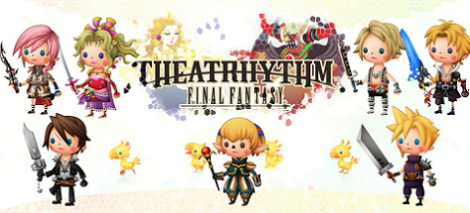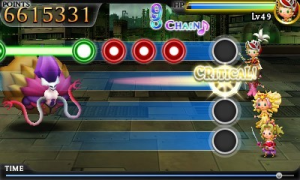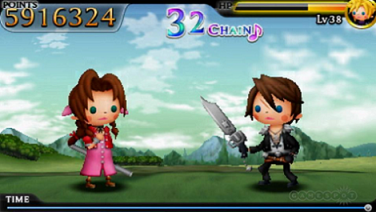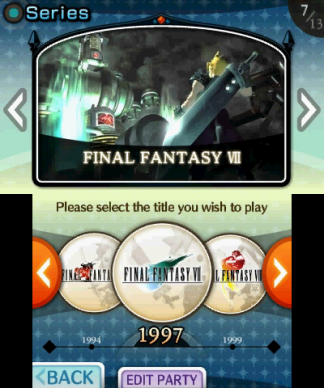|
Disclosure: We may earn a commission from links on this page
|
Developer: indies0zero | Publisher: Square-Enix |
| Release Date: July 3, 2012 | Available On: 3DS |

I have been meaning to publish my review for Theatrhythm: Final Fantasy for quite some time, but the truth is, I’ve spent most of my free time playing this new 3DS spin-off since its release on July 3. If that ruins the “surprise” of my final opinion in this critique, I apologize: as a long-time fan of the Final Fantasy franchise, it’s hard to deny just how powerful the feeling of nostalgia within this spin-off can be.
The “Recipe”:
The music of Final Fantasy I-XIII + (Elite Beat Agents + Rock Band) =
Theatrhythm: Final Fantasy
Although it is obvious that Theatrhythm is a “fan service” that was released in celebration of the series’ 25th anniversary, casual players can still find a lot to enjoy from the rhythm/music side of Theatrhythm, even if they aren’t familiar with the subtle RPG-like mechanics or the endless Final Fantasy references. It’s a very entertaining, accessible, and addictive title that keeps you tapping along to the beat of each classic Nobuo Uematsu song, spanning the entire 13-game franchise. In all, there are more than 40 songs packaged in the box, with even more confirmed to appear in bundles – the 3DS’s first major paid DLC.

Playing the notes is simple enough; most of the tempo notes can be tapped with the stylus, but you have to quickly swipe in certain directions for some of the “emphasized” notes, or hold and slide on the bottom screen to drag out the longer parts. The songs in the game are categorized into three unique “stages”, with each presenting a completely different interface for playing the notes. For example, the Event Music Stages are dynamic, with a free-flowing interface that is based around the tempo of some of the series’ most epic, moving orchestral pieces. To add some extra flash, the developers designed montages that are compiled of scenes from the best moments of each game in the series (see below).

Moving on, the Field Music Stages are based on the smooth, trance-inducing style of the “overworld themes” featured throughout the series; I felt like they were easiest to play, and appropriately relaxing. On the other hand, the Battle Music Stages (pictured above) speed up the tempo and pump out far more notes, reflecting the intense battles from each installment. In addition to being very challenging, these stages seemed to utilize the game’s RPG-style elements to a larger degree than the Field and Event stages.
Basically, you can choose four heroes for your “party”, and each can be leveled up, equipped with skills and abilities, and even use items that are acquired as you play through the game. These aspects of Theatrhythm aren’t as involving as the actual rhythm/music portion, but they spice it up in a way that Final Fantasy fans will nonetheless appreciate.
The most immediately-noticeable part of Theatrhythm: Final Fantasy is its visual style; as you can see from the screenshots in this article, the game is very colorful and features a “chibi” design for its versions of the series’ characters and enemies. I personally loved the design, and though it probably won’t appeal to all Final Fantasy fans, I thought it made this spin-off stand out among the rest of the games in the franchise.

Of course it’s the music, not the graphics, that are the real star of Theatrhythm: Uematsu’s score from each installment sounds the same as you will remember, from the primitive MIDI tunes in the 8-bit and early 16-bit entries all the way to the complex pieces from the recent games. The sound effects that go along with the note-tapping on the bottom screen really add some emphasis to the unforgettable melodies, particularly the yellow “slide” notes.

Perhaps the only drawback to the beautiful visual design and flashy effects that accompany the gameplay is the distraction that comes from everything on the screen. Keeping in mind that this is a music/rhythm-based game; Theatrhythm generally requires a certain degree of focus just to play the notes well, regardless of your personal familiarity with the music. This makes some of the exciting summon sequences and many of the highly-detailed backgrounds more of a problematic distraction, and not so much a satisfying part of the playing experience. Even the “Critical!” prompts that flash when you hit a perfect note are usually distracting, as the text obscures the playing field (see the image above) and makes it difficult to see the next note in line. I only mention these issues as observations, because ultimately they do not make the game look, sound, or play any worse; they are just factors to remember when playing.
Theatrhythm’s only other minor issues come up when you think about its use of the 3DS’s various capabilities and features. It is a mixed bag, but even with the following comments considered, functions like StreetPass and even the 3D effect have a minor impact on the playing experience.

The 3D effect actually looks great, and goes a long way to bring out the detail found within the backgrounds. Unfortunately, it also ends up being a distraction a large portion of the time. This is particularly an issue during the Event Music Stages, which include all of the CG scenes and video clips from each FF title. These really add some flash and take you back to some exciting moments in the series, but ultimately the depth effect makes it pretty difficult to see the notes as they appear on the screen.
There is a multiplayer option, but only for the “Dark Notes” found within the “Chaos Shrine” mode. I’ll discuss those below; for now, I would like to express how disappointed I am that Theatrhythm does not utilize any kind of online play, leaderboards, etc. The only multiplayer is local, and Download Play isn’t supported. Ouch.
The gameplay is solid all-around, but I had some issues with my hands cramping if I played for longer periods of time. In fact, I was glad I kept the plastic stand that came with my copy of Kid Icarus: Uprising – resting the 3DS on the stand made it much easier to play the game comfortably.
There are three modes of play, starting with “Series Mode”. In this mode, you play through each installment of Final Fantasy, unlocking each track for “Challenge Mode” after finishing each game. This mode only takes a few hours to tap through, but it really only begins to scratch the surface of the content offered in Theatrhythm.

As I mentioned before, there is a Challenge Mode that includes the basic version of each song, as well as “Expert” and “Ultimate” tracks. Completing all of the tracks for each game on Expert/Ultimate unlocks the tougher versions in Series Mode, so you can even go back to play through again on harder settings. Finally, the “Chaos Shrine” contains all of your Dark Notes; 99 of these unique song pairings can be found and completed to unlock rare items. The Dark Notes are generally tougher and play differently than the versions found in Challenge and Series mode, and because the songs in each pair can be chosen from any FF title, it is difficult to anticipate the tracks that you will be forced to play.

Theatrhythm is definitely best in “small doses”, but it takes plenty of time to make a dent in its vast amount of extras and unlockable content. For perspective purposes, I spent more than a dozen hours playing the game, and only unlocked roughly a third of the goodies found in the “Museum”. These include video clips from each Final Fantasy title, viewable in the “Theater”; additional music tracks from the series, playable in the “Music Player”; 70+ collectible cards called “Collectacards”, and 64 “Trophies” that act as Achievements, charting your milestones as you play through the game. Finally, you earn stars for total use stats, time played, completion, and countless random factors – Square-Enix ranks and grades you for everything, so perfectionists could possibly spent as much time collecting everything on this 3DS game as a full-fledged Final Fantasy installment.
I only have two final, tiny “notes”:
1. Why is the “boss fight” system in the Chaos Shrine so ridiculously complicated? Collecting all of the rare items from each of the three possible bosses found in every Dark Note could take an obscene amount of effort, simply because the process of fighting each boss isn’t explained very clearly.
2. The Collectacards are cool, and unlocking Holofoil/Platinum versions of each is even cooler, but the coolest option would have been to use them in a new “Tetra Master” game, similar to the ones found in Final Fantasy VIII and IX. This isn’t really a “flaw”, but having a sweet card game to play against friends could have been a great option for additional multiplayer content.
All of these things considered, Theatrhythm: Final Fantasy is ultimately the best way for any dedicated fan of the franchise to celebrate its 25th anniversary. With two and a half decades of Nobuo Uematsu’s fantastic compositions, a vast roster of classic characters and villains, a surprising amount of content, and gameplay that is both addictive and accessible, this one really comes as a surprise – it’s the best Final Fantasy spin-off that I have ever played, and gave me the urge to play one of the classic games on multiple occasions.
| Graphics: | 9.5 |
| Sound: | 10 |
| Gameplay: | 9 |
| Creativity: | 7.5 |
| Replay Value/Game Length: | 9 |
| Final: | 9 out of 10 |
| Written by Cliff Bakehorn | Write a User Review |